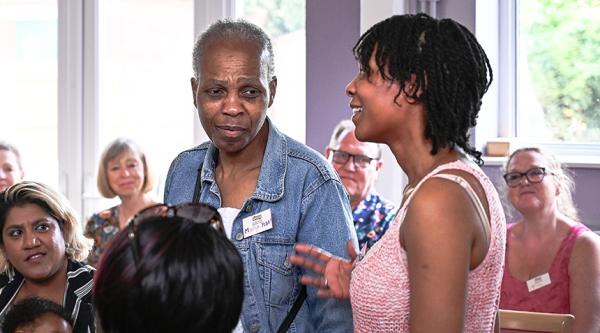Information
Why is digital design important for someone affected by dementia?
Find out why it’s important to create accessible websites, apps and software for people affected by dementia. Discover who our Dementia Voice team are and how we can work with you on your website accessibility.
Many people will turn to online resources if they are worried about their memory, or coping with a diagnosis. It’s vital that these sources of help and support are easy to find, use and comprehend.
The importance of digital accessibility for people with dementia
Digital inclusion can transform the lives of those affected by dementia. We all go online to access goods and services and to connect with others but having access to technology is especially important to people with dementia. It helps maintain their independence, keeps them connected and safe and helps them stay active and live well.
If websites and mobile apps are difficult to navigate and online documents hard to find and understand, people with dementia can lose connections and face being left isolated.
6.9 million people will face becoming digitally excluded if nothing is done to help them. Taking simple steps to make your digital platforms, websites and apps accessible and quick and easy to use doesn’t just have a positive impact on your customers, it’s good for your organisation too, leading to greater engagement and customer satisfaction.
How our work is informed by Dementia Voice
Every aspect of our work is informed by people who have dementia, so we can give expert advice and guidance to the businesses we support. Our team of consultants work alongside people with dementia to review our partners websites, apps and digital platforms.
They make sure they’re dementia friendly and with a proven record of expertise they can offer insights and recommendations to improve accessibility.
Find out more about Ellie our Dementia Voice Participant
Ellie was diagnosed with young-onset dementia and is a Dementia Voice Participant (often referred to as ‘user involvement’). She works with Alzheimer's Society using her personal experiences to help shape the work that we do.
5 things to consider when designing for dementia
1. Include people affected by dementia
People with a dementia diagnosis should be included in all stages of design. Not only will this help you understand, validate and meet real needs, but it’ll also help improve your empathy for those you are designing for.
However, it can be hard to find and to recruit people affected by dementia. We recommend:
- visiting people affected by dementia, rather than bringing them to you. You will learn more about their context of use, and reduce the burden on them
- using online dementia communities, like Dementia Support Forum and Reddit to reach representative people
- approaching local services in your area, like Dementia Cafes
- using social media, like X (formerly known as Twitter) and Facebook
- consider using specialist research participant recruiters.
2. Writing, words and terms
People with dementia may struggle with language, like remembering a word or terminology. Therefore use very clear, specific and explicit language. This means:
- using simple, clear, direct and precise prose, headings and labels
- using explicit and arresting content
- using dementia positive language, such as 'living with' rather than 'suffering from' dementia
- avoiding generic calls to action, complex wordplay, jargon
- avoiding using abbreviations and acronyms.
3. Layout, navigation and interface design
People with dementia can struggle to remember things and become disorientated. Try to make navigation explicit and signpost a route back to the homepage, or the start. This can be achieved by:
- providing a clear link to 'Home' or the start
- using clear section breaks to make splits and stages obvious
- making hyperlink styles, and states, like ‘visited link’ clear
- avoiding splitting tasks across multiple screens
- avoiding hiding navigation off-screen.
4. Colours and contrast
Each type of dementia can damage the visual system in a number of different ways. Dementia also tends to affect older people, although it can affect younger people. This can mean that age-related visual decline may affect the person living with a diagnosis, or their carers too.
When designing digital user interfaces consider:
- using high contrast colour schemes to improve readability
- using plain backgrounds, rather than patterns or images, for textual content
- avoiding the use of blue, especially for important interface components.
5. Dementia-friendly text and fonts
Making letter shapes and words simple and easy to perceive improves readability and comprehension for all people on all devices.
Our tips to make words more readable include:
- using sans-serif fonts because the letter shapes are generally more readable on digital screens
- using larger text sizes (and higher contrasts) to provide more information to the eye. This is especially important for older people whose visual system declines with age
- avoid using multiple fonts, unnecessarily. This may make the interface and content confusing.
Inclusivity beyond dementia
Most of these dementia-friendly design guidelines are inclusive in nature. This means that they can improve the ease of use of a service for many people, even if they don't have dementia.
This is an important part of accessible and inclusive design practice to consider.
Accessibility is not just the law; it's a fantastic idea.
That said, these guidelines are particularly important for people affected by dementia.
Contact us about dementia and accessibility guidance
Digital inclusion can transform the lives of people with dementia. Contact Alzheimer’s Society today for more information on how to make your products and services more accessible on hotline@alzheimers.org.uk



